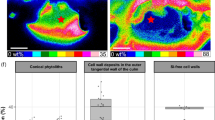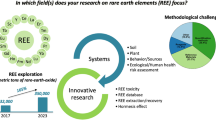Abstract
Purpose
Information on the physicochemical properties, mineral species and micromorphology of lateritic soils and gravel soil layers in paleo-environmental soil profile is severely lacking. Red soil profile of the Taoyuan terrace was employed to demonstrate its different extents of lateritic weathering. The objectives of this study were to compare the physicochemical properties of lateritic soils and gravel soil layers and identify using conventional and synchrotron X-ray diffraction (XRD) analyses mineral species in nanoparticles separated by automated ultrafiltration device (AUD) apparatus.
Materials and methods
Soil samples were collected from paleo-environmental lateritic soils. Soil samples were examined using elemental analysis, conventional and synchrotron XRD analyses, high gradient magnetic separation, separation and collection of nanoparticles by AUD apparatus, and transmission electron microscopy (TEM).
Results and discussion
The soil pH, redness index, quantities of free Al- and Fe-oxides (Ald and Fed), and clay content of lateritic soils are higher than those of gravel soil layers. Illite, kaolinite, gibbsite, quartz, goethite, and hematite were identified in clay fractions and nanoparticles by conventional and synchrotron XRD analyses. TEM images show presence of hematite nanoparticles on the surface coating of kaolinite nanoparticles and aggregated hematite nanoparticles overlapping the edge of a kaolinite flake in a size range of 4–7 nm. Synchrotron XRD techniques are more straightforward and powerful than conventional XRD with random powder methods for identifying nanoparticles in red soils, particularly for illite, kaolinite, goethite, and hematite nanoparticles. According to chemical compositions of clay fractions and red soil features in the Taoyuan terrace, these red soils can be taken as lateritic red earths or red earths.
Conclusions
This work suggests that physicochemical properties, mineral species, and micromorphology of red soil at all depths can shed light on the extent of paleo-environmental lateritic weathering.








Similar content being viewed by others
References
Aniku JRF, Singer MJ (1990) Pedogenic iron oxide trends in a marine terrace chronosequence. Soil Sci Soc Am J 54:147–152
Bernas B (1967) A new method for decomposition and comprehensive analysis of silicates by atomic absorption spectrometry. Anal Chem 40:1682–1683
Bohn HL, McNeal BL, O’Connor GA (1985) Soil chemistry. Wiley, New York, p 341
Brewer R (1976) Fabric and mineral analysis of soils. Krieger, New York, p 482
Brindley GW (1980) Quantitative X-ray minerals analysis of clays. In: Brindley GW, Brown G (eds) Crystal structure of clay minerals and their X-ray identification. Mineralogical Society monograph no. 5. Mineralogical Society, London, pp 411–438
Bullock P, Fedoroff N, Jongerius A, Stoops G, Tursina T (1985) Handbook for soil thin section description. Waine Research, Wolverhampton, p 152
Buol SW, Sanchez PA (1986) Red soils in the Americas: morphology, classification and management. In: Academia Sinica Institute of Soil Science (ed) Proceedings of the international symposium on red soil. China Science, Beijing, pp 14–43
Chang S (1971) Subsurface geologic study of the area from the Taipei Basin to the Kuanyin shelf, Taoyuan, Taiwan. Petroleum Geology of Taiwan, no. 9. pp 123–144
Chen YG, Liu TK (1991) Radiocarbon dates of river terraces along the lower Tahachi, northern Taiwan: their tectonic and geomorphic implications. Proc Geol Soc China 34:337–347
Chen WF, Teng LS (1990) Depositional environment of Quaternary deposits of the Linkou terrace, northwestern Taiwan. Proc Geol Soc China 33:39–63
China Soil Survey Office (1987) China soils. China Science, Beijing, p 746. (in Chinese with English abstract)
Chiu HT (1968) The Hsinchuang fault in the Taoyuan area, northern Taiwan. Proc Geol Soc China 11:50–73
Chuang RY, Chen YG, Wang Y, Lee CT (2002) River terraces correlation of lower reach of Tahanchi and its implications on neotectonics. 2002 Annual meeting of Geological Society of China: program and expanded abstract, pp 347–349 (in Chinese with English abstract)
Dixon JB (1977) Kaolin and serpentine group minerals in minerals in soil environments. In: Dixon JB, Weed SB (eds) Minerals in soil environments, 1st edn. Soil Sci Soc Am, Madison, pp 397–403
Eswaran H, Ikawa H, Kimble JM (1986) Oxisols of the world. In: Academia Sinica Institute of Soil Science (ed) Proceedings of the international symposium on red soil. China Science, Beijing, pp 90–123
Fiskell JA, Perkins HF (1970) Selected coastal plain soil preperties. South Coop Ser Bull Univ Florida Gainesville 148:144–152
Gong ZT (1986) Biogeochemistry of red weathering crust in China. In: Academia Sinica Institute of Soil Science (ed) Proceedings of the international symposium on red soil. China Science, Beijing, pp 124–158
Grim RE (1953) Clay mineralogy. McGraw-Hill, New York, p 317
Hiemenz PC (1986) Principles of colloid and surface chemistry, 2nd edn. Revised and expanded. Polytechnic University Press, Pomona, p 815
Ho CS (1988) An introduction to the geology of Taiwan—explanatory text of the geologic map of Taiwan, 2nd edn. Central Geological Survey, The Ministry of Economic Affairs, Taipei, p 192
Hseu ZY, Chen ZS (1996) Saturation, reduction, and redox morphology of seasonally flooded Alfisols in Taiwan. Soil Sci Soc Am J 60:941–949
IUSS Working Group WRB (2006) World reference base for soil resources 2006. World soil resources reports no. 103. FAO, Rome, p 128
Jackson ML (1979) Soil chemical analysis—advanced course, 2nd edn. University of Wisconsin, Madison, p 246
Klug HP, Alexander LE (1974) X-ray diffraction procedures for polycrystalline and amorphous materials, 2nd edn. Wiley, New York
Laidlaw I, Steinmetz M (2005) In: Scott DJ, Harding SE, Rowe AJ (eds) Analytical ultracentrifugation: techniques and methods. Royal Society of Chemistry, Cambridge, pp 270–290
Lin YS, Chen YG, Chen ZS, Hsieh ML (2005) Soil morphological variations on the Taoyuan terrace, northwestern Taiwan: roles of topography and groundwater. Geomorphology 69:138–151
Loveland PJ, Dighy P (1984) The extraction of Fe and Al by 0.1 M pyrophosphate solutions: comparison of some techniques. J Soil Sci 35:243–250
McKeague JA, Bryson JE, Miles JM (1971) Differentiation of form of extractable iron and aluminum in soils. Soil Sci Soc Am J 35:33–38
Mehra OP, Jackson ML (1960) Iron oxides removed from soils and clays by a dithionite–citrate system buffered with sodium bicarbonate. Clays Clay Minerals 7:317–327
Mohr ECJ, Baren FA, Van Schuylenborg J (1972) Tropical soils: a comprehensive study of their genesis, 3rd edn. Monton-Ichitor, The Hague, p 481
Muir A, Anderson B, Stephen I (1957) Characteristics of some Tanganyika soils. J Soil Sci 8:1–8
Pai CW, Wang MK, Wang WM, Houng KH (1999) Smectites in iron-rich calcareous soil and black soils of Taiwan. Clays Clay Mineral 47:389–398
Ranville JF, Chittleborough DJ, Beckett R (2005) Particle-size and element distributions of soil colloids: Implication for colloid transport. Soil Sci Soc Am J 69:1173–1184
Rhoades JD (1982) Cation exchange capacity. In: Page AL (ed) Methods of soil analysis, part 2, 2nd edn. ASA and SSSA, Madison, pp 149–157
Sanchez P (1976) Properties and management of soils in the tropics. Wiley, New York, p 618
Schulze DG, Dixon JB (1979) High gradient magnetic separation of iron oxides and other magnetic minerals from soil clays. Soil Sci Soc Am J 43:793–799
Schwertmann U, Taylor RM (1989) In: Dixon JB, Weed SB (eds) Minerals in soil environments, 2nd edn. Book Series No. 1. SSSA, Madison, pp 379–438
Shao PH, You SL, Su TW (2005) The lastest geological evolution of southwestern area in Taipei Basin based on thermoluminescene analysis of sediments from Sanchiao fault drilling core SCF14-17. 2005 annual meeting of Geological Society located in Taipei program and extended, pp 182
Shao PH, Shea KS, Wang MK, Shau YH, Chiang KY, Tsao TM (2010) Red soils developed from Quaternary deposits on the Linkuo terrace, Northern Taiwan. Clay Minerals 45:315–326
Singh B, Gilkes RJ (1992a) Properties and distribution of iron oxides and their association with minor elements in the soils of south-eastern Australia. J Soil Sci 43:77–98
Singh B, Gilkes RJ (1992b) Properties of soil kaolinites from south-western Australia. J Soil Sci 43:645–667
Soil Survey Staff (1999) Soil taxonomy: a basic system of soil classification for making and interpretation soil surveys, 2nd edn. Agriculture handbook, 436. United States Department of Agriculture and Natural Resources Conservation Service, Washington, DC, p 869
Soil Survey Staff (2010) Keys to soil taxonomy, 11th edn. United States Department of Agriculture and Natural Resources Conservation Service, Washington, DC
Song FF, Chang CH, Liu CY, Chang SH, Jeng U, Lai YH, Liu DG, Chung SC, Tsang KL, Yin GC, Lee JF, Sheu HS, Tang MT, Hwang CS, Hwu YK, Liang KS (2007) X-ray beamlines for structural studies at the NSRRC superconducting wavelength shifter. J Synchro Rad 14:320–325
Stoops GJ, Buol SW (1985) Micromorphology of oxisols. In: Douglas LA, Thompson ML (eds) Soil micromorphology and soil classification. Special publication no. 15. SSSA, Madison, pp 106–119
Sung QC, Lu MT, Tsai H, Liew PM (1997) Discussion on the genetics and the correlation of river terraces in Taiwan. J Geol Soc China 40:31–46
Taiwan Central Geological Survey (2005) Physical and chemical properties of lateritic stratum in Linkou/Taoyuan terraces. Taiwan Central Geological survey report, no. 94-01, pp 42–59 (in Chinese with English abstract)
Taiwan Civil Aeronautics Administration (2005-2009) Aerodrome climatological annual summaries for Taiwan Taoyuan airport, air navigation and weather services. Civil Aeronautics Administration, Taipei City
Tomida Y (1937) Correlation of the geomorphologic surface of the terraces along the river coast of Tanshuiho. Taiwan Tigaku Kizi 13:101–119 (in Japanese)
Torrent J, Alferez F (1983) Quantitative relationships between soil color and hematite content. J Soil Sci 136:354–358
Torrent J, Schwertmann U, Schulze DG (1980) Iron oxide mineralogy of some soils of two river terrace sequences in Spain. Geoderma 23:191–208
Tsao TM, Wang MK, Huang PM (2009a) Automated ultrafiltration device for efficient collection of environmental nanoparticles from aqueous suspensions. Soil Sci Soc Am J 73:1808–1816
Tsao TM, Wang MK, Huang PM (2009b) An apparatus for collecting nanoparticles. U.S. Patent Application, no. 7501063B2, March 10
Tsao TM, Chen YM, Wang MK, Huang PM (2011) Structural transformation and physicochemical properties of environmental nanoparticles by comparison of various particle-size fractions. Soil Sci Soc Am J 75:533–541
US EPA (1996) Microwave assisted acid digestion of siliceous and organically based matrices. Method 3052, EPA SW-846, Ch 3.2. United States Environmental Protection Agency, Washington, DC
Wan HM, Chen SH (1988) The relationship between laterization, chemical and mineralogical characterizations, and weathering of gravels in Linkuo terrace. Ti Chih 8:27–47 (in Chinese with English abstract)
Zhao QQ, Shi H (1986) On the genesis, classification and characteristics of the soils in tropical and subtropical China. In: Institute of Soil Science, Academia Sinica (ed) Proceedings of the international symposium on red soil. China Science, Beijing, pp 197–228
Acknowledgments
This study was financially supported by the National Science Council, Taiwan under grant no. NSC-100-2313-B-002-007 and no. B02 project of the experimental forest, National Taiwan University. We would like to express our most sincere gratitude to the late Prof. P.M. Huang, Department of Soil Science, University of Saskatchewan, for his valuable advice provided throughout the entire study.
Author information
Authors and Affiliations
Corresponding author
Additional information
Responsible editor: Michael Kersten
Rights and permissions
About this article
Cite this article
Tsao, T.M., Chen, Y.M., Sheu, H.S. et al. Red soil chemistry and mineralogy reflect uniform weathering environments in fluvial sediments, Taiwan. J Soils Sediments 12, 1054–1065 (2012). https://doi.org/10.1007/s11368-012-0495-z
Received:
Accepted:
Published:
Issue Date:
DOI: https://doi.org/10.1007/s11368-012-0495-z




